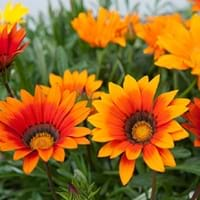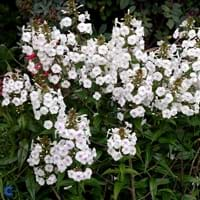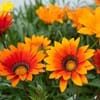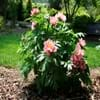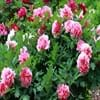Life Span
Annual
Perennial
Type
Flowering Plants, Ornamental Plants, Shrub
Flowering Plants
Origin
Australia, Mediterranean, New Zealand, United States
United States, Northeastern United States, Mid-Atlantic United States, Southeastern United States, Central United States, South-Central United States
Types
Treasureflower, Terracotta Gazania
Not Available
Number of Varieties
Not Available
Habitat
Lower slopes, meadows
Loamy soils, meadows, moist forests
USDA Hardiness Zone
9-11
5-8
Sunset Zone
4, 5, 6, 7
1a, 1b, 2a, 2b, 3a, 3b, 4, 5, 6, 7, 8, 9, 10, 11, 12, 13, 14, 18, 19, 20, 21, 22, 23
Habit
Spreading
Upright/Erect
Flower Color
Orange, Orange Red, Yellow
White, Pink, Lavender, Violet
Flower Color Modifier
Bicolor
Bicolor
Fruit Color
Not Available
Not Available
Leaf Color in Spring
Green
Green, Dark Green
Leaf Color in Summer
Green
Dark Green
Leaf Color in Fall
Green
Dark Green
Leaf Color in Winter
Green
Not Available
Leaf Shape
Lanceolate
Oblong
Plant Season
Spring, Summer
Summer
Sunlight
Full Sun, Partial Sun
Full Sun, Partial Sun, Partial shade
Growth Rate
Medium
Medium
Type of Soil
Loam, Sand
Clay, Loam
The pH of Soil
Acidic
Acidic, Neutral, Alkaline
Soil Drainage
Well drained
Average
Bloom Time
Early Spring, Spring, Late Spring
Early Summer
Tolerances
Not Available
Not Available
Where to Plant?
Container, Ground
Container, Ground
How to Plant?
Seedlings, Stem Cutting
Seedlings, Transplanting
Plant Maintenance
Medium
Medium
Watering Requirements
Do not water the foliage, Needs very little water
Do Not over Water, Keep ground moist
In Summer
Moderate
Lots of watering
In Spring
Moderate
Moderate
In Winter
Average Water
Average Water
Soil pH
Acidic
Acidic, Neutral, Alkaline
Soil Type
Loam, Sand
Clay, Loam
Soil Drainage Capacity
Well drained
Average
Sun Exposure
Full Sun, Partial Sun
Full Sun, Partial Sun, Partial shade
Pruning
Prune if you want to improve plant shape, Remove dead or diseased plant parts
Remove damaged leaves, Remove dead branches, Remove dead leaves
Fertilizers
All-Purpose Liquid Fertilizer, organic fertlizers, slow-release fertilizers
All-Purpose Liquid Fertilizer, Apply 10-10-10 amount
Pests and Diseases
Red blotch
Leafhoppers, Pink Root, Powdery mildew, Red blotch
Plant Tolerance
Heat Tolerance, Sun
Drought
Flower Petal Number
Single
Single
Foliage Texture
Fine
Medium
Foliage Sheen
Glossy
Glossy
Attracts
Butterflies
Hummingbirds, Butterflies
Allergy
Abdominal distension, flushing of face, Tight chest
allergic conjunctivitis, breathing problems, Irritate the mucus membrane
Aesthetic Uses
Bouquets, Cottage Garden, Showy Purposes
Beautification, Cottage Garden
Beauty Benefits
Anti-ageing, Beautiful Skin, Skin cleanser
Improve skin tone, Restores Hair Colour, Skin cleanser
Environmental Uses
Fixes Nitrogen, Forms dense stands
Air purification, Increases moisture in air, Prevent Soil Erosion
Medicinal Uses
anti-inflammatory, Rheumatism
Aging, Antispasmodic
Part of Plant Used
Leaves
Leaves
Other Uses
Florist trade and landscaping, Showy Purposes, Used for fragrance
Air freshner, Cosmetics, Making Sweet Scented Oil
Used As Indoor Plant
No
No
Used As Outdoor Plant
Yes
Yes
Garden Design
Container, Hanging Basket, Mixed Border, Rock Garden / Wall, Wildflower
Cutflower, Mixed Border
Botanical Name
PHLOX nivalis
PHLOX maculata
Common Name
Trailing Phlox
Meadow Phlox
In Hindi
Gazania
मैदानी एक प्रकार का पौधा
In German
Gazania
Wiese Phlox
In French
Gazania
Meadow Phlox
In Spanish
Gazania
prado Phlox
In Greek
Gazania
Meadow Phlox
In Portuguese
Gazania
Meadow Phlox
In Polish
Gazania
łąka Phlox
In Latin
Gazania
Phlox meadow
Phylum
Magnoliophyta
Magnoliophyta
Class
Magnoliopsida
Magnoliopsida
Order
Asterales
Solanales
Family
Asteraceae
Polemoniaceae
Clade
Angiosperms, Asterids, Eudicots
Not Available
Tribe
Arctotideae
Not Available
Subfamily
Cichorioideae
Not Available
Number of Species
Not Available
Season and Care of Gazania and Meadow Phlox
Season and care of Gazania and Meadow Phlox is important to know. While considering everything about Gazania and Meadow Phlox Care, growing season is an essential factor. Gazania season is Spring and Summer and Meadow Phlox season is Spring and Summer. The type of soil for Gazania is Loam, Sand and for Meadow Phlox is Clay, Loam while the PH of soil for Gazania is Acidic and for Meadow Phlox is Acidic, Neutral, Alkaline.
Gazania and Meadow Phlox Physical Information
Gazania and Meadow Phlox physical information is very important for comparison. Gazania height is 15.20 cm and width 30.00 cm whereas Meadow Phlox height is 60.00 cm and width 38.10 cm. The color specification of Gazania and Meadow Phlox are as follows:
Gazania flower color: Orange, Orange Red and Yellow
Gazania leaf color: Green
Meadow Phlox flower color: White, Pink, Lavender and Violet
- Meadow Phlox leaf color: Green and Dark Green
Care of Gazania and Meadow Phlox
Care of Gazania and Meadow Phlox include pruning, fertilizers, watering etc. Gazania pruning is done Prune if you want to improve plant shape and Remove dead or diseased plant parts and Meadow Phlox pruning is done Remove damaged leaves, Remove dead branches and Remove dead leaves. In summer Gazania needs Moderate and in winter, it needs Average Water. Whereas, in summer Meadow Phlox needs Lots of watering and in winter, it needs Average Water.
